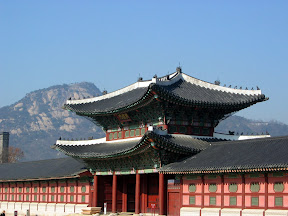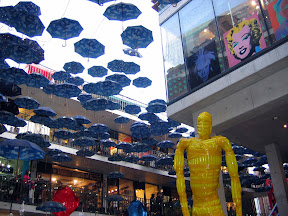Big day in Seoul
Seoul is by far the most tourist friendly of all the huge Asian cities I’ve been. When you arrive, head straight to one of the many kiosks scattered about the tourist areas, especially the bustling markets of Namdaemun and Dongdaemun. These information centers provide free maps, brochures, and even a lengthy book listing Seoul’s best restaurants for traditional Korean cuisine. Even if the restaurants are out of your price range it’s still worth picking up for the beautiful pictures of food and ideas for your next culinary adventure.
We started out in Namdaemun Market, the best place for cheap gifts and small souvenirs. Chiaki is a much better barterer than me. She picks a young Korean guy and slowly starts breaking him down. By the time she had finished talking Lee-san’s price down by ₩15,000 he turned to me and asked if I was sure she wasn’t Korean. I took it as a compliment, to her or me I’m not sure.
After buying all our omiage (Japanese souvenir gifts), we ducked into the narrow food alley for a great lunch of cold spicy noodles (bibimkimsu) and Korean style pancakes (Pajeon). We ended up coming back to this restaurant because the women serving were so fun. On our second visit Chiaki got hugs. Japanese-Korean relations on the mend!
Namdaemun is also close to one of Seoul’s ancient city gates, Sungnyemun. From the gate we took a rather lengthy stroll up to Gyeongbokgung, the work in progress that was once the emperial palace before the Japanese destroyed it…twice. The first time was about 450 years ago and then again during the 35 year occupation before and during the war.
Gyeongbokgung is impressive yet suited for travelers new to Asia. I’ve had my fair share of temples and pagodas in Japan, and on the surface these kind of places all start to look the same, only in Korea the dominat tones are green rather than red. Big deal. Since ancient Japanese cites didn’t have walls to protect from invaders, I was more interested in the gates scattered about inner Seoul, the last remaining evidence of these barriers.
Walking up the massive Namdaemunno street from Sungnyemun provides a good picture of Seoul’s immensity. There is no defined downtown, nor the pockets of skyscrapers dotting Tokyo’s skyline, although some specific commercial districts are on the rise. The majority of the central city is a random mix of buildings of all sizes with high-rise apartment blocks circling the core. Most Koreans seem to live in apartments as we saw few houses in Seoul.
We followed Cheonggyecheon creek from Gyeongbokgung down to another massive gate, Dongdaemun, surrounded by Asia’s largest outdoor market that shares it’s name. The creek is a new urban renewal project, the brainchild of Seoul’s green mayor. It was bustling with holiday excitement, it’s sunken concrete walkways and patios packed with people admiring the impressive Christmas light displays on both banks. It is a great way to get to Dongdaemun, especially if you’re in the trendy Insadong art district.
Dongdaemun market is the highlight of Seoul. You can spend hours exploring its narrow alleys filled with every random thing you can imagine. By this time we had walked all day and were losing steam, unfortunately, so we had to duck out of the market and head home to rest before dinner.
Tags: Capitals tour of Asia, Korea





Leave a Reply